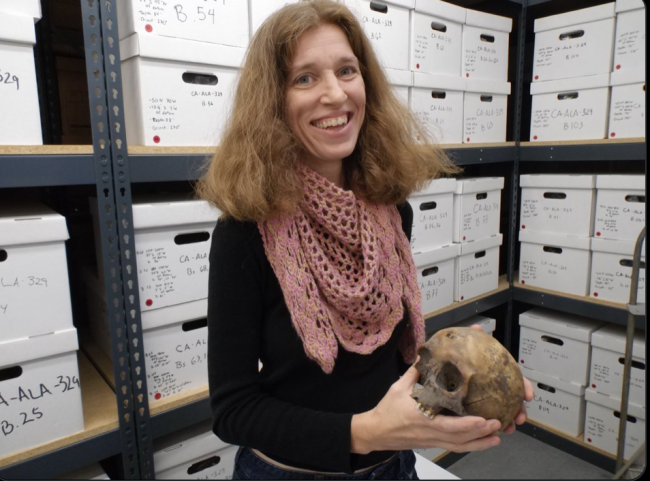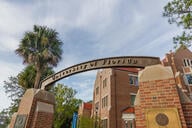You have /5 articles left.
Sign up for a free account or log in.

Image from Elizabeth Weiss’s controversial Twitter post
Twitter/Elizabeth Weiss
A professor of physical anthropology is suing San José State University, saying she’s being retaliated against for her controversial stance on the repatriation of skeletal remains for reburial.
In two examples of alleged retaliation, Elizabeth Weiss says she was suddenly removed as curator of the university’s collection of remains, a role she’d held for 17 years, and locked out of the research facility itself.
The lawsuit accuses San José State of multiple violations of Weiss’s First Amendment rights.
Most of the bones in question were found in Alameda County, Calif., and range from 500 to 3,000 years old, Weiss said in an interview. They are in the process of being repatriated, but she would like access to them until they’re gone.
Weiss, who remains a faculty member, doesn’t know if she’ll ever again see the skeletal X-rays that are part of the university’s collection, either, even though she said these X-rays are not subject to federal or state laws governing repatriation.
“It’s not an exaggeration to say ‘lock me out,’ because they literally changed the locks on me,” Weiss said of San José State. “I have to rebuild my research career. And them locking me out of the collection, out of the curation facility, and not allowing me to see what other possibilities there are for me is really hindering my ability to start.”
Weiss also says that her dean and her department chair hosted a panel for deans and chairs during an online leadership conference last year called “What to Do When a Tenured Professor Is Branded a Racist.” Weiss, who watched the panel, says her supervisors used a pseudonym to discuss this theoretical racist professor, but as she’s the only tenured physical anthropologist in the department, they were clearly talking about her. She says her chair referred to her, indirectly, as a white supremacist and suggested she was professionally incompetent.
The chair allegedly said during the talk that he would take adverse action against “Prof. Jones” were she not tenured, and that he’d take a “very different approach” if “Jones” tried to teach her repatriation views in the future.
Weiss’s department chair, Roberto González, forwarded an interview request to a university spokesperson, who denied multiple requests for comment. Her dean did not respond to an interview request.
‘I’m Against Reburying Bones’
Weiss says that her views against repatriation have long been known in her department but that her colleagues only started to hold them against her in 2020, upon the publication of her new book. Prior to that, she says, she was repeatedly praised for her work and even received the College of Social Sciences’ Austen D. Warburton Award of Merit for excellence in scholarship in 2019.
Weiss’s 2020 book, Repatriation and Erasing the Past (University of Florida Press), was co-written with lawyer James Springer. It argues that returning bones to their ancestral burial grounds instead of keeping them to study now and in the future limits scientific advancement, and that the federal Native American Graves Protection and Repatriation Act (NAGPRA) and parallel state laws on repatriation undermine the Constitution’s Establishment Clause by favoring religion over science.
“I’m against reburying bones. I think they can tell us a lot about the past,” Weiss said of her views. “I think they can be used to train forensic anthropologists. I think that they are a key resource for young anthropologists, for archaeologists, forensic anthropologists, and I think that we still have a lot to learn from skeletal remains. I also think that a collection is not something that you study once and then it can be repatriated, because as you build knowledge on the collection, it helps you ask deeper questions as you learn more about the collection.”
Weiss also said that linking older bones to modern tribes for return is often imprecise, even with DNA analysis, as peoples have migrated over time and there are no tribe-specific genetic markers.
“I think that this kind of creates a false link that’s based mainly on geography, even though people have been moving around for millennia,” she said. “The other aspect is that I think that repatriation is a bigger part of an ideology that basically states that the story that you tell, or who recreates the past, is more important than the facts for recreating the past. My perspective is that the best, most accurate story doesn’t depend on who’s telling it. It depends on the quality of the research.”
These views, as expressed in Weiss’s book, were received by some in the field as insensitive, out of touch with current norms in physical anthropology and archaeology, and even racist.
One co-authored response to Weiss’s book, published in the International Journal of Cultural Property, says, “Many archaeologists are increasingly placing ethics at the forefront of our practice, with growing emphasis on the importance of Indigenous consultation and research partnership. Although we acknowledge that there is still an epistemological gap between Western scientific and Indigenous or Native American perspectives, we feel encouraged that this gap is increasingly being bridged by collaborative work.”
Weiss’s book therefore “stands in stark contrast with contemporary anthropological practice, scorning decades of the complex navigations undertaken to repair and revitalize relationships between bioarchaeologists and traditionally oppressed people,” the article says.
An open letter from a group of scholars to Weiss, her co-author and the University Press of Florida demanded that the press not make the book open access, to avoid further harm to Indigenous communities and scholars. While the scholars said they had not reached a consensus on demanding retraction, they also asked that the press actively promote counterexamples to Weiss’s work.
‘This is Not a Knee-Jerk Reaction’
“This is not a knee-jerk reaction by bioarchaeologists and archaeologists to the current social media attention of this book,” the letter says, quoting parts of Weiss’s book. “Rather, anthropologists as a group are reacting strongly to the authors’ idea that repatriation is an ‘ideology of victimization’ (pgs. 3-4); to their assertion that laws such as NAGPRA mean ‘deference to Native American perspective’ that ‘creates unfair advantage’ (pg. 94); to their incorrect assertion that ‘the courts have practiced religious discrimination and racial discrimination in their admission and weighing of evidence’ (pg. 183) related to oral traditions of Indigenous groups; and to the authors’ scientistic claim that ‘repatriation hinders scientific research’ (pg. 194).”
The press never pulled the book, but Weiss faced renewed criticism last year, when she wrote an op-ed arguing against updates to the state law on repatriation known as CalNAGPRA (she called the them "NAGPRA on steroids") and posted on Twitter a photo of herself handling a skull from San José State’s collection. She captioned that photo, “So happy to be back with some old friends." Immediately she was accused online—including by some anthropologists—of being a “monster,” of handling the remains like a “trophy” and of violating cultural and professional norms by sharing a photo of remains on social media.
“3D scan the bone, take MRI and CT data, hell, even a trabecular core sample. AND THEN RETURN IT,” one Twitter user wrote in response in Weiss’s photo. “With today’s technology there is no reason you should be hoarding the bones of a society’s ancestors.”
The day after Weiss’s Twitter post, Vincent J. Del Casino Jr., San José State’s provost, sent a memo to the campus saying that the photo had “evoked shock and disgust from our Native and Indigenous community on campus and from many people within and outside of SJSU.” Del Casino further said that there were “many things” in the image that don’t align with “the values of SJSU or of academic inquiry,” and that the university “does not condone or endorse the practice of posing with the human remains of others.”
Weiss said she was taken aback by the wave of criticism, as she’d previously taken photos with the items in the university’s collection with no incident—sometimes at the university’s request for public relations purposes, as recently as last year. (San José State’s anthropology advising hours website shows Weiss with skulls in the background, for instance, and she’s holding a skull on this faculty webpage.) She also said that while she disagrees with federal and state repatriation laws, she follows them closely and teaches her students about a variety of perspectives on repatriation, not just her own.
A Legal Warning
To that latter point, Weiss says in her lawsuit that following the “What to Do When a Tenured Professor Is Branded a Racist” panel, she asked her chair and her dean for a letter affirming her right to assign her book, to speak about her research in class and to access skeletal remains for research purposes. She also asked that her chair retract what she perceived to be the threats against her. She said she was told by her dean that the Office of Faculty Affairs would not allow him to write such a letter and that the chair would not retract his statements. The dean also allegedly told Weiss that he was facing pressure to take action against her. After this, Weiss had her lawyer send the university a letter saying any retaliatory actions taken against her would violate her First Amendment rights.
“Professor Weiss’s speech is unquestionably about a matter of public concern within her profession,” Weiss’s lawyer with the Pacific Legal Foundation wrote to the university. “To the contrary, the discussion and debate of potentially controversial viewpoints is the essence of the university experience and merits rigorous First Amendment protection.”
Weeks later, the university announced a new policy regarding the curation facility, which transferred control over access to the collection from Weiss as curator to the university’s NAGPRA coordinator and a newly appointed tribal liaison.
San José State has defended this action as complying with CalNAGPRA and as a response to conversations with the Muwekma Ohlone tribe, which supports repatriation of the remains. Weiss says in her lawsuit that the “university faced no legal duty to implement the directive, and the timing of and statements related to the interim directive make clear that the policy is designed to retaliate against” her. The university is allegedly only allowing students to assist in sorting the collection for repatriation, which Weiss cites as more evidence of retaliation.
Weiss says she was temporarily restricted from working with even the non–Native American remains in the collection, including a collection from Carthage. When she was finally granted access, she says, the Carthage remains had been moved from the collection facility to two rooms outside the facility, one of which is an active classroom and therefore not appropriate for research use.
San José State’s anthropology department allegedly organized an antiracism speaker series in response of Weiss’s book, but the university denied Weiss’s request to hold a parallel speaker series. The department also posted a statement to its website regarding her tweet, saying, “Although our department is committed to academic freedom, we strongly disapprove of the post and do not condone such practices. The ideas and words of a single faculty member do not represent the values of the anthropology department as a whole. All human remains should be treated with dignity and respect.”
The incident “prompted us to confront gaps in the anthropology department’s policies regarding the handling and depiction of human remains,” the statement continues. “In the past, the department lacked an explicit policy about photographing remains, though it was codified in course syllabi and generally accepted as a standard of practice.” San José State’s new directive now outlines “stricter protocols regarding access to SJSU’s curational facility—including a firm prohibition of video and photography of Native American remains. We enthusiastically welcome these developments.”
Standards of Practice
Weiss’s lawsuit argues that despite this statement, “There is no generally accepted standard of practice that discourages the publication of photographs of professors holding or interacting with skeletal remains.” (For the record, Weiss said that she wasn’t wearing gloves because it can be easier to drop remains with gloves.)
At the very least, Weiss’s post clearly violated some unwritten norms and standards for handling remains. But is there an articulated standard for the field? The American Anthropological Association said it doesn’t have standards, policies and guidelines concerning the ethical treatment of human remains in research collections. For that reason, the group recently commissioned a task force to recommend such standards for dealing with all human remains, not just those subject to NAGPRA.
“The association urges anthropologists to familiarize themselves with the AAA principles of responsible professional conduct, applicable laws and standards of free, prior, and fully informed consent,” the association said in a statement. “We also urge universities and their faculty and staff reach out to the descendant communities to determine and subsequently respect their wishes as to the remains that anthropologists encounter in their research.”
Asked why there remains gray area as to what to do with Native American remains some 30 years after the passing of NAGPRA, Jeff Martin, spokesperson for the association, said via email that "human remains and related materials in anthropological research collections and museum collections extend far beyond the circumstances to which NAGPRA and its accompanying implementing regulations apply. NAGPRA only applies to Native American human remains and grave goods found on federal lands; there are lots of human remains and associated materials that are not on federal lands, including Native American human remains that are found in cities and on private lands in rural areas, and also including forgotten cemeteries."
Richie Meyers, director of graduate studies at Oglala Lakota College in South Dakota and past president of the Association of Indigenous Anthropologists, a subsection of the AAA, didn’t argue that Weiss should lose her job over her views, but he said it’s impossible to do good anthropological science by treating bones as mere bones, divorced from the larger cultural interests and values of the discipline.
“Being a lab rat is what comes to mind,” he said of looking at Weiss’s tweet. “I think that’s the problem with academia—a lot of times, there’s a disconnect between being in the institutional setting versus the field, as they call it. When you’re in the field, you’re dealing with humanity … So if she had more experience in the field with legitimate people in Native communities, I feel like she wouldn’t be doing what she’s doing.”
Meyers also said that framing the debate at San José State as one of science versus repatriation ignores the research possibilities that could be forged from building relationships between scholars and tribes.
He further challenged Weiss’s assertion that repatriation laws can force a false link between older remains and modern tribes based on geography alone, saying, “People who still live with collective identities and in tribal communities don’t have the American individual identity that affords you the luxury to call these people outside of your people. The idea of your people is a concept that you carry with you in a different collective sense. It’s an identity that’s very different.”
Elizabeth A. DiGangi, an associate professor of anthropology at Binghamton University whose research centers on bioarchaeology and forensic anthropology, agreed with the idea that good anthropological science of any kind, even skeletal, can't be done in a cultural vaccuum.
"Respect for the bones inherently includes respect for the living—and deceased—humans who were family or community members of those people to whom the bones belonged," she said. "You can't separate those out."





